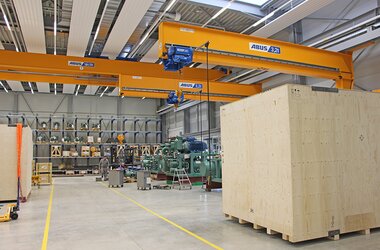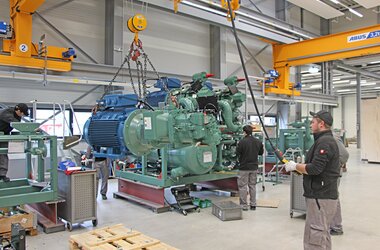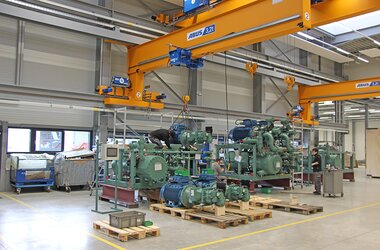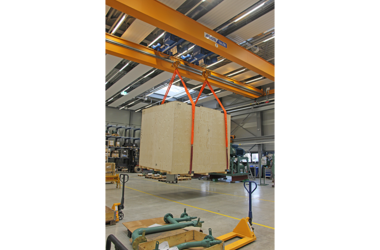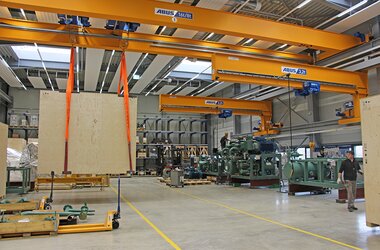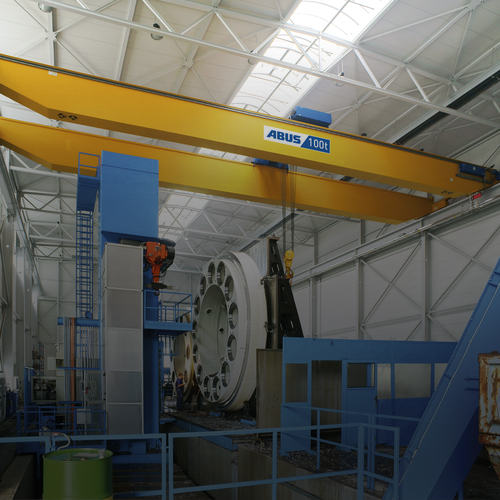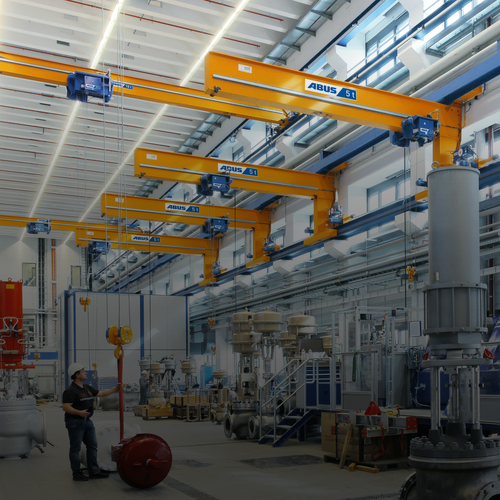ABUS EOT cranes for German manufacturer of air conditioning and refrigeration technology
Our lives would be unthinkable without the use of modern air conditioning and refrigeration technology. Compressor solutions are used everywhere whether it be climate control, unbroken cold chains for foodstuffs or challenging process cooling in industrial thermal engineering. Ammonia is the preferred cooling agent in the industrial setting. The BITZER group (www.bitzer.de) has been offering components for ammonia for over 40 years and the innovative BITZER Ammonia Compressor Packs (ACPs) offer solutions for the most demanding cooling requirements. These BITZER ACPs are manufactured in the new plant at BITZER’s site in Rottenburg am Neckar southwest of Stuttgart in Germany inaugurated in January 2019. In this new plant welding is carried out on frames, pipe components, and oil separators among other things. Once the ACPs have been assembled they are packaged for transport and dispatched worldwide; the BITZER Group is present in over 90 countries worldwide with 72 sites and over 3,800 employees.
Loads of up to 2 tonnes were dealt with in the previously existing buildings; however, the new site challenges the lifting and crane technology now to handle loads of up to 12 tonnes: that is how much the heaviest BITZER ACPs can weigh once they are fully packaged. The objective for the new plant had been to be able to handle these complete loads on site. They wanted to be able not only to transport the individual components weighing up to 2 tonnes during assemblage but also to carry out the ensuing transport of the finished products on site. This required all crane tracks to be arranged on two levels in order to use all cranes on the same site. It had also to be possible to use all cranes independently of each other. Thus two single girder wall travelling cranes EWL with 3.2 tonnes SWL and spans of 8 metres are used in the plant with an ABUS double girder EOT crane ZLK travelling above them. This ZLK crane has a load capacity of 16 / 8 tonnes, features two hoists, and has a span of 19.26 metres. The single girder wall travelling cranes running on the lower level really come into their own during final assemblage: they are used to lift the larger components such as electric motors, compressors, and oil separators and to transport them to the allocated sites in order to be fitted into the metal frames of the corresponding ACPs by the employees. As the wall travelling cranes are travelling along the walls it is it possible to use one of these cranes to serve several workstations. The cranes are controlled via push button pendants. This allows the individual components to be positioned very precisely. Overload protection as well as collision prevention devices for cranes and hoists ensure maximum safety for crane users and for the material to be handled.
The double girder EOT crane of the ZLK type is fitted with two separately operating electric wire rope hoists with maximum SWLs of 16 and 8 tonnes respectively. However, the limit of the total lifting capacity of the crane is 16 tonnes and this is achieved via a total load limiting system. This crane is mostly used with both hoists operating simultaneously when APCs packed into their large and heavy wooden crates need to be lifted, moved, and deposited precisely. Both hoists are used for this lifting process because of the asymmetric centre of gravity of the loads and the loads are attached at two points. This in turn requires the hoists to be fitted with synchronisation controls: both hoists are synchronised in case of unbalanced loads and during tandem cross travelling the hoist travelling speeds are constantly harmonised. Both safety features are provided by the crane control ABUControl. ABUControl monitors even lifting, lowering, and travelling in the required speeds. In addition, the anti-sway system may be activated in order to reduce load sway quite considerably: load sway that is a result of the crane’s and hoists’ movements. This makes it even easier to position the loads in a precise location even if the crane users are not yet very experienced. Furthermore, frequency control provides infinitely variable acceleration and the keeping of any selected speeds. The double girder EOT crane is controlled via a radio remote control ABURemote Button which allows both hoists of this crane to be operated either individually or together. This remote control lets the user choose his position from where to operate the crane and move the load from a safe place with the best possible overview of crane and load. The load suspended from the crane is displayed via a large LED matrix display on the crane bridge as well as on the display of the radio remote control.
The BITZER group is now well equipped for the future with their new assemblage area for their innovative solutions and the ABUS material flow technology in use.

